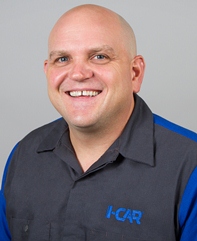
June is National Safety Month, which is the perfect time to talk about the importance of repair procedures! We’ve been on the ground talking to repair shops, insurance companies, and industry experts, and we’re hearing more and more about the importance of using repair procedures—not only to ensure the safety of repairs, but also to improve DRP relationships and profitability for shop owners. That said, there are also challenges that shops face when it comes to incorporating repair procedures into their production process.

Jason Bartanen is the Director of Industry Technical Relations at I-CAR. His current main responsibilities include working with our industry technical relations team on the I‑CAR Repairability Technical Support Initiative. They will soon be launching a new website around Repairability Technical Support to provide information from a variety of vehicle makers, including repair procedures clarification.
Why are repair procedures important?
Unfortunately, not as many technicians are using repair procedures as should be. I think one of the most common reasons for this is experience level and the misconception that experience replaces the need to use procedures. We often hear people say, “I’ve been doing collision repairs for 20 or 30 years.” Which is great, but we’re not working on 20 or 30 year old vehicles anymore. We’re working on late model vehicles, and no two vehicles are built the same anymore.
The only way to know what you’re working on and what the vehicle maker instructions call for is to have those repair procedures at your fingertips. With the high‑ and ultra‑high‑strength steels that exist on today’s vehicles, a technician might be doing things that they shouldn’t be doing and potentially compromising some of those five star crash ratings that vehicle makers are so keen on getting.
If they’re applying heat or straightening things that they shouldn’t be, they’re definitely compromising the structural integrity of that vehicle; and they might not even know it. To what extent, we don’t know. Unfortunately, we need to go through another collision event to know exactly how much damage we’re inflicting on that vehicle.
Should shops be following repair procedures on every repair?
Absolutely. It’s important to always have the latest and greatest information because vehicle makers do, from time to time, change recommendations and offer different position statements. It’s important to research that every time; be well advised to do the research and make sure that the repair procedure that you’re using is applicable and up to date.
One of things we want to do at I-CAR, with our Repairability Technical Support Initiative, is get the word out about new materials and new vehicles and the tools, equipment, techniques, and training that are required for complete, safe and quality repairs.
How do repair procedures affect parts procurement?
It’s not just about the technician having access to repair procedure information. The estimator should have access to that information, as well as the insurance adjuster.
Making sure that you order the parts earlier in the repair process is going to be advantageous, too—improving the cycle time in addition to ensuring complete, safe and quality repairs.
In terms of profitability for repair shops, are there any financial benefits to following procedures?
There is significant emphasis on KPIs in today’s collision repair world and on things like touch time, efficiency, CSI and cycle time. Having OEM repair information at your fingertips is going to help with all of those things. Obviously, if you’re following the repair procedures and you’re doing the repair correctly the first time, you’re going to have higher customer satisfaction. You’re going to improve your cycle time by knowing which parts require replacement, recalibration, etc.
You can build procedures into the entire repair plan because you know up front what you’re going to be working on, how the vehicle needs to be repaired, and all of the parts and equipment needed for the repair. Repair procedures make a big difference when it comes to shop performance.
How does your work support the industry and improve availability of repair procedures for shops?
As part of the I-CAR Repairability Tech Support Initiative, we’re actively working with the vehicle manufacturers to try to identify and close the gaps that still exist. I think that vehicle makers have more collision repair information available than they ever have before. But where there are gaps that exist, I-CAR is working with vehicle manufacturers that haven’t had as much information available. The work that we’re doing complements the information that CCC ONE Repair Methods has. Basically, we’re working to make sure that the best collision repair possible is available to technicians.